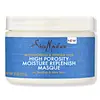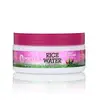What's inside
What's inside
 Benefits
Benefits

 Concerns
Concerns

 Ingredients Side-by-side
Ingredients Side-by-side

Water
Skin ConditioningCetearyl Alcohol
EmollientButyrospermum Parkii Butter
Skin ConditioningCaprylic/Capric Triglyceride
MaskingStearamidopropyl Dimethylamine
EmulsifyingBehentrimonium Chloride
PreservativeParfum
MaskingHydrogenated Vegetable Oil
EmollientSchinziophyton Rautanenii Kernel Oil
EmollientSimmondsia Chinensis Seed Oil
EmollientAloe Barbadensis Leaf Juice
Skin ConditioningAdansonia Digitata Seed Oil
EmollientPanthenol
Skin ConditioningHydroxyethylcellulose
Emulsion StabilisingSodium Chloride
MaskingPolysorbate 60
EmulsifyingDisodium Phosphate
BufferingCaprylyl Glycol
EmollientSodium Citrate
BufferingBenzoic Acid
MaskingWater, Cetearyl Alcohol, Butyrospermum Parkii Butter, Caprylic/Capric Triglyceride, Stearamidopropyl Dimethylamine, Behentrimonium Chloride, Parfum, Hydrogenated Vegetable Oil, Schinziophyton Rautanenii Kernel Oil, Simmondsia Chinensis Seed Oil, Aloe Barbadensis Leaf Juice, Adansonia Digitata Seed Oil, Panthenol, Hydroxyethylcellulose, Sodium Chloride, Polysorbate 60, Disodium Phosphate, Caprylyl Glycol, Sodium Citrate, Benzoic Acid
Water
Skin ConditioningCetearyl Alcohol
EmollientBehentrimonium Methosulfate
Glycerin
HumectantBehentrimonium Chloride
PreservativeDipropylene Glycol
HumectantParfum
MaskingCetyl Alcohol
EmollientCetyl Esters
EmollientAloe Barbadensis Leaf Juice
Skin ConditioningBrassica Campestris Seed Oil
Skin ConditioningCitrus Junos Peel Extract
Skin ConditioningPolyglyceryl-3 Diisostearate
EmulsifyingOryza Sativa Bran Extract
Skin ConditioningCetrimonium Chloride
AntimicrobialPanthenol
Skin ConditioningSodium PCA
HumectantPhenoxyethanol
PreservativeBenzoic Acid
MaskingEthylhexylglycerin
Skin ConditioningGlycereth-2 Cocoate
EmulsifyingPolysorbate 20
EmulsifyingWater, Cetearyl Alcohol, Behentrimonium Methosulfate, Glycerin, Behentrimonium Chloride, Dipropylene Glycol, Parfum, Cetyl Alcohol, Cetyl Esters, Aloe Barbadensis Leaf Juice, Brassica Campestris Seed Oil, Citrus Junos Peel Extract, Polyglyceryl-3 Diisostearate, Oryza Sativa Bran Extract, Cetrimonium Chloride, Panthenol, Sodium PCA, Phenoxyethanol, Benzoic Acid, Ethylhexylglycerin, Glycereth-2 Cocoate, Polysorbate 20
Ingredients Explained
These ingredients are found in both products.
Ingredients higher up in an ingredient list are typically present in a larger amount.
Aloe Barbadensis Leaf Juice comes from leaves of the aloe plant. Aloe Barbadensis Leaf Juice is best known for helping to soothe sunburns. It is also anti-inflammatory, moisturizing, antiseptic, and can help heal wounds.
Aloe is packed with good stuff including Vitamins A, C, and E. These vitamins are antioxidants, which help fight free-radicals and the damage they may cause. Free-radicals are molecules that may damage your skin cells, such as pollution.
Aloe Barbadensis Leaf Juice also contains sugars. These sugars come in the form of monosaccharides and polysaccharides, folic acid, and choline. These sugars are able to help bind moisture to skin.
It also contains minerals such as calcium, 12 anthraquinones, fatty acids, amino acids, and Vitamin B12.
Learn more about Aloe Barbadensis Leaf JuiceThis ingredient is a preservative and often used for it's anti-static properties. You'll most likely see this ingredient in hair conditioners.
It does not cause irritation or sensitization in leave-on products at 1-5%.
Benzoic Acid is used to preserve and adjust the pH of products.
The antimicrobial property of Benzoic Acid helps elongate a product's shelf life. Its main role is to reduce fungi growth and is not found to be effective at fighting bacteria. Therefore Benzoic Acid is always added along with other preservatives.
In its pure form, Benzoic Acid looks like a white crystalline solid. It has slight solubility in water.
The name of Benzoic Acid comes from gum benzoin, which used to be the sole source of deriving this ingredient. Benzoic Acid is the most simple aromatic carboxylic acid.
Benzoic Acid is naturally occuring in strawberries, mustard, cinnamon, and cloves. It has a slight scent but is not considered to be a fragrance.
Learn more about Benzoic AcidCetearyl alcohol is a mixture of two fatty alcohols: cetyl alcohol and stearyl alcohol. It is mainly used as an emulsifier. Emulsifiers help prevent the separation of oils and products. Due to its composition, it can also be used to thicken a product or help create foam.
Cetearyl alcohol is an emollient. Emollients help soothe and hydrate the skin by trapping moisture.
Studies show Cetearyl alcohol is non-toxic and non-irritating. The FDA allows products labeled "alcohol-free" to have fatty alcohols.
This ingredient is usually derived from plant oils such as palm, vegetable, or coconut oils. There is debate on whether this ingredient will cause acne.
Due to the fatty acid base, this ingredient may not be Malassezia folliculitis safe.
Learn more about Cetearyl AlcoholPanthenol is a common ingredient that helps hydrate and soothe the skin. It is found naturally in our skin and hair.
There are two forms of panthenol: D and L.
D-panthenol is also known as dexpanthenol. Most cosmetics use dexpanthenol or a mixture of D and L-panthenol.
Panthenol is famous due to its ability to go deeper into the skin's layers. Using this ingredient has numerous pros (and no cons):
Like hyaluronic acid, panthenol is a humectant. Humectants are able to bind and hold large amounts of water to keep skin hydrated.
This ingredient works well for wound healing. It works by increasing tissue in the wound and helps close open wounds.
Once oxidized, panthenol converts to pantothenic acid. Panthothenic acid is found in all living cells.
This ingredient is also referred to as pro-vitamin B5.
Learn more about PanthenolParfum is a catch-all term for an ingredient or more that is used to give a scent to products.
Also called "fragrance", this ingredient can be a blend of hundreds of chemicals or plant oils. This means every product with "fragrance" or "parfum" in the ingredients list is a different mixture.
For instance, Habanolide is a proprietary trade name for a specific aroma chemical. When used as a fragrance ingredient in cosmetics, most aroma chemicals fall under the broad labeling category of “FRAGRANCE” or “PARFUM” according to EU and US regulations.
The term 'parfum' or 'fragrance' is not regulated in many countries. In many cases, it is up to the brand to define this term.
For instance, many brands choose to label themselves as "fragrance-free" because they are not using synthetic fragrances. However, their products may still contain ingredients such as essential oils that are considered a fragrance by INCI standards.
One example is Calendula flower extract. Calendula is an essential oil that still imparts a scent or 'fragrance'.
Depending on the blend, the ingredients in the mixture can cause allergies and sensitivities on the skin. Some ingredients that are known EU allergens include linalool and citronellol.
Parfum can also be used to mask or cover an unpleasant scent.
The bottom line is: not all fragrances/parfum/ingredients are created equally. If you are worried about fragrances, we recommend taking a closer look at an ingredient. And of course, we always recommend speaking with a professional.
Learn more about ParfumWater. It's the most common cosmetic ingredient of all. You'll usually see it at the top of ingredient lists, meaning that it makes up the largest part of the product.
So why is it so popular? Water most often acts as a solvent - this means that it helps dissolve other ingredients into the formulation.
You'll also recognize water as that liquid we all need to stay alive. If you see this, drink a glass of water. Stay hydrated!
Learn more about Water